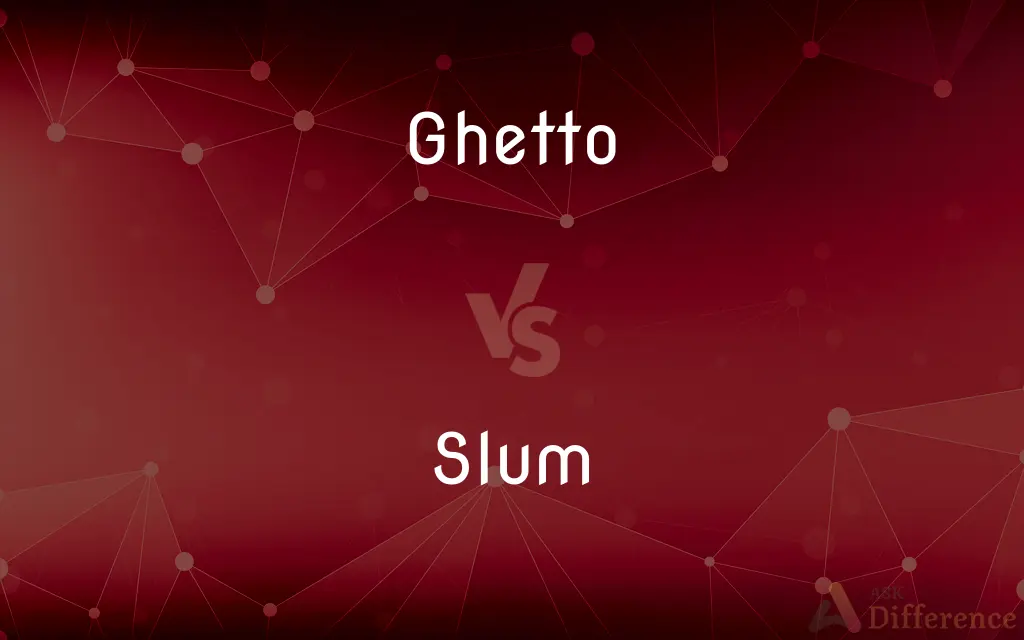Ghetto vs. Slum — What's the Difference?
By Tayyaba Rehman & Maham Liaqat — Updated on March 25, 2024
Ghetto typically refers to a part of a city, especially a poor area, occupied by a minority group, while a slum denotes a densely populated, squalid area of a city inhabited by the very poor.

Difference Between Ghetto and Slum
Table of Contents
ADVERTISEMENT
Key Differences
Ghettos are often associated with segregation, where minority or marginalized groups are confined within certain parts of cities. These areas can result from social, economic, or legal pressures, concentrating residents based on ethnicity, religion, or socioeconomic status. Whereas slums are characterized by inadequate housing and squalor, existing as a result of rapid urban population growth and economic disparity, without necessarily being defined by the ethnicity or race of their inhabitants.
While ghettos historically emerged in part due to discriminatory policies or practices, such as those seen in Europe for Jewish populations or racial segregation in the United States, slums often evolve due to urbanization challenges. These include insufficient urban planning, poverty, and lack of affordable housing, leading to overcrowded living conditions.
The infrastructure in ghettos might vary, ranging from relatively stable buildings to more deteriorated conditions, reflecting the economic abilities of their residents. On the other hand, slums are generally marked by very poor living conditions, including lack of access to clean water, sanitation, and durable housing, highlighting neglect from urban planning and government support.
Social dynamics in ghettos can be complex, with communities developing a rich cultural identity and tight-knit social bonds amid adversity. Slums, while also harboring strong community ties, face severe social challenges, including higher rates of crime, unemployment, and social exclusion, stemming from their marginalization and economic conditions.
Education and employment opportunities in ghettos are often limited by external perceptions and systemic barriers, further entrenching poverty and segregation. Slums suffer from similar limitations, compounded by the physical and health challenges of living in squalid conditions, making upward mobility exceptionally difficult for residents.
ADVERTISEMENT
Comparison Chart
Definition
Part of a city where minorities are segregated.
Densely populated, poor urban area.
Origin
Social, legal, economic pressures.
Urbanization, insufficient planning.
Housing
Varies; can be stable or deteriorated.
Generally squalid, inadequate.
Social Dynamics
Strong cultural identity, segregation.
Strong community ties, marginalization.
Challenges
Systemic barriers, limited opportunities.
Health, overcrowding, limited opportunities.
Compare with Definitions
Ghetto
An area characterized by poverty and severe social disadvantages.
The ghetto faced issues like high unemployment and crime rates.
Slum
A highly populated urban residential area consisting mostly of closely packed, decrepit housing units.
The slum was notorious for its overcrowded living conditions.
Ghetto
An urban area with limited access to resources and opportunities.
Life in the ghetto is marked by struggles against systemic barriers.
Slum
A neighborhood where inhabitants are primarily impoverished.
The slum's population struggled daily to meet basic needs.
Ghetto
A section of a city where a minority group lives due to social, legal, or economic pressure.
The city's ghetto was historically a Jewish neighborhood.
Slum
Represents the challenges of rapid urbanization and inadequate housing.
The city's slums grew quickly as people moved in, seeking jobs.
Ghetto
A term used to describe places of isolation caused by discrimination.
Laws enforced racial ghettos in the early 20th century.
Slum
Places where the community bonds over shared struggles.
Despite the hardships, there's a sense of unity in the slum.
Ghetto
Places where marginalized communities develop a strong cultural identity.
The ghetto is known for its vibrant street art and music.
Slum
An area suffering from a lack of hygiene, sanitation, and clean water.
Diseases were rampant in the slum due to poor sanitation.
Ghetto
A ghetto (Italian pronunciation: [ˈɡetto]; from Venetian ghèto, 'foundry'), often the ghetto, is a part of a city in which members of a minority group live, especially as a result of social, legal, or economic pressure. Ghettos are often known for being more impoverished than other areas of the city.
Slum
A slum is a highly populated urban residential area consisting of densely packed housing units of weak built quality. The infrastructure in slums is often deteriorated or incomplete, and it's primarily inhabited by impoverished people.
Ghetto
A usually poor section of a city inhabited primarily by people of the same race, religion, or social background, often because of discrimination.
Slum
A heavily populated urban area characterized by substandard housing and squalor
Grew up in a slum near downtown.
Lived in the slums by the river.
Ghetto
An often walled quarter in a European city to which Jews were restricted beginning in the Middle Ages.
Slum
To visit impoverished areas or squalid locales, especially out of curiosity or for amusement.
Ghetto
Something that resembles the restriction or isolation of a city ghetto
"trapped in ethnic or pink-collar managerial job ghettoes" (Diane Weathers).
Slum
(countable) A dilapidated neighborhood where many people live in a state of poverty.
Ghetto
In a manner typical or stereotypical of an impoverished urban area, as in being makeshift, garish, or crass
"I pick up the pair of very big, very ghetto, door-knocker bamboo earrings" (Meesha Mink and De'nesha Diamond). "Isn't chewing gum when accepting an award very ghetto?" (Vibe).
Slum
Inexpensive trinkets awarded as prizes in a carnival game.
Ghetto
An (often walled) area of a city in which Jews are concentrated by force and law. Used particularly of areas in medieval Italy and in Nazi-controlled Europe.
Slum
(slang) Slumgullion; a meat-based stew.
Ghetto
An (often impoverished) area of a city inhabited predominantly by members of a specific nationality, ethnicity, or race.
Slum
(intransitive) To visit a neighborhood of a status below one's own.
Ghetto
An area in which people who are distinguished by sharing something other than ethnicity concentrate or are concentrated.
Slum
To saunter about in a disreputable manner.
Ghetto
An isolated, self-contained, segregated subsection, area or field of interest; often of minority or specialist interest.
Slum
A foul back street of a city, especially one filled with a poor, dirty, degraded, and often vicious population; any low neighborhood or dark retreat; - usually in the plural; as, Westminster slums are haunts for theives.
Ghetto
Of or relating to a ghetto or to ghettos in general.
Slum
Same as Slimes.
Ghetto
Unseemly and indecorous or of low quality; cheap; shabby, crude.
My apartment's so ghetto, the rats and cockroaches filed a complaint with the city!
I like to drive ghetto cars; if they break down you can just abandon them and pick up a new one!
Slum
To visit or frequent slums, esp. out of curiosity, or for purposes of study, etc. Also called go slumming.
Ghetto
Characteristic of the style, speech, or behavior of residents of a predominantly black or other ghetto in the United States.
Slum
A district of a city marked by poverty and inferior living conditions
Ghetto
Having been raised in a ghetto in the United States.
Slum
Visit slums for entertainment or out of curiosity
Ghetto
To confine (a specified group of people) to a ghetto.
Ghetto
A quarter of a city where Jews live in greatest numbers.
I went to the Ghetto, where the Jews dwell.
Ghetto
Any section of a town inhabited predominantly by members of a specific ethnic, national or racial group, such segregation usually arising from social or economic pressure. The term is commonly applied to areas in cities having a high concentration of low-income African-Americans.
Ghetto
Any isolated group of people.
Ghetto
Any group isolated by external pressures, with an implication of inferiority.
Ghetto
Formerly the restricted quarter of many European cities in which Jews were required to live;
The Warsaw ghetto
Ghetto
Any segregated mode of living or working that results from bias or stereotyping;
The relative security of the gay ghetto
No escape from the ghetto of the typing pool
Ghetto
A poor densely populated city district occupied by a minority ethnic group linked together by economic hardship and social restrictions
Common Curiosities
What causes the formation of ghettos?
Ghettos form due to social, economic, and legal pressures that segregate minority groups.
Can a ghetto also be a slum?
Yes, a ghetto can also be a slum if it has poor living conditions, but not all ghettos are slums.
Are ghettos and slums the same?
No, ghettos are areas where minorities are segregated, often due to discrimination, while slums are characterized by squalor and overcrowding.
How do slums develop?
Slums develop due to rapid urbanization, poor planning, and the economic inability of residents to afford better housing.
Do ghettos have any positive aspects?
Despite challenges, ghettos can have strong community ties and rich cultural identities.
What is the difference in living conditions between ghettos and slums?
Slums generally have worse living conditions, with more pronounced squalor and infrastructure issues.
Is segregation still a cause for ghettos today?
Yes, segregation, both formal and informal, still contributes to the existence of ghettos.
How does urban planning affect slums?
Inadequate urban planning can lead to the expansion of slums, exacerbating living conditions.
Can slum upgrading programs transform slums?
Yes, effective slum upgrading can significantly improve living conditions and integrate slums into the urban fabric.
What are common problems in slums?
Common problems include inadequate housing, lack of sanitation, and health risks.
How do governments address slum conditions?
Efforts include slum upgrading, providing basic services, and affordable housing projects.
What role does discrimination play in the formation of ghettos?
Discrimination based on race, ethnicity, or religion can lead to the forced segregation of communities into ghettos.
What is the global prevalence of slums and ghettos?
Slums and ghettos are found worldwide, particularly in cities with significant economic disparities and historical segregation practices.
How do residents of ghettos and slums cope with their challenges?
They develop strong community networks, engage in informal economies, and sometimes mobilize for rights and services.
What impact does poverty have on slums and ghettos?
Poverty exacerbates the challenges faced by residents, limiting access to services and opportunities for improvement.
Share Your Discovery

Previous Comparison
Desolate vs. Isolate
Next Comparison
Marsh vs. MoorAuthor Spotlight
Written by
Tayyaba RehmanTayyaba Rehman is a distinguished writer, currently serving as a primary contributor to askdifference.com. As a researcher in semantics and etymology, Tayyaba's passion for the complexity of languages and their distinctions has found a perfect home on the platform. Tayyaba delves into the intricacies of language, distinguishing between commonly confused words and phrases, thereby providing clarity for readers worldwide.
Co-written by
Maham Liaqat













































